Connected devices and artificial intelligence are turning continuous clinical data into real-time actions at the bedside and on mobile. This shift helps clinicians spot risks, speed interventions, and improve patient care.
Market momentum matters: the integrated market is set to grow rapidly, creating a strategic window for providers to modernize programs and capture measurable outcomes.
Real deployments like URMC’s Butterfly iQ and Teladoc’s AI-augmented virtual care show how edge analytics and NLP raise visibility on underreported events such as falls and medication errors. At the same time, more than 86 million connected healthcare devices underscore why security-by-design and endpoint verification are essential.
Iottive offers end-to-end BLE app development, device integration, and cloud/mobile orchestration to help healthcare teams build scalable, interoperable systems that drive faster time-to-intervention and better patient outcomes.
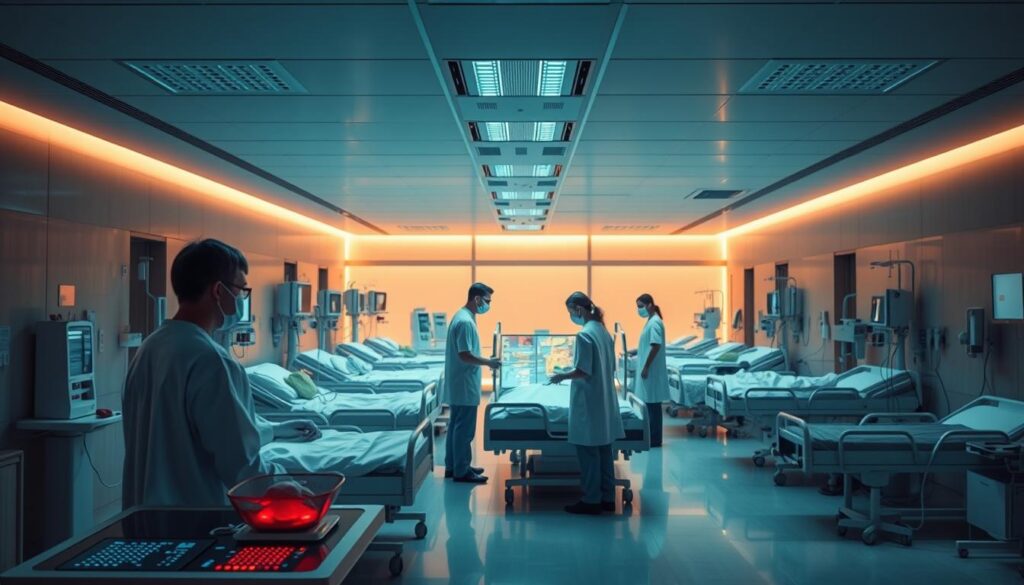
Key Takeaways
- AI and connected sensors convert data into actionable alerts for clinicians.
- Rapid market growth creates urgency for providers to adopt modern systems.
- Edge analytics and NLP improve detection of falls, errors, and incidents.
- Security-by-design, endpoint checks, and observability are critical as devices scale.
- Iottive can support BLE integration, device platforms, and cloud/mobile orchestration.
What AIoT Means for Hospital Safety Today and in the Future
Modern edge compute and connected sensors let clinicians act on vital signs and behavior in near real time. This shift moves healthcare from batch upload and central processing to fast, local decisions that fit bedside workflows.
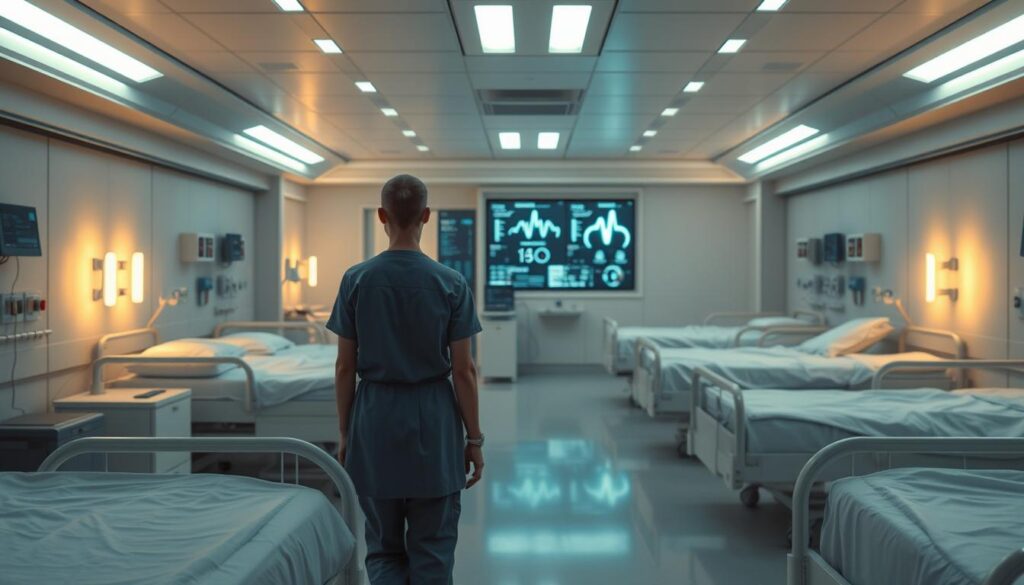
From data collection to real-time intelligence at the edge
Devices now do more than report telemetry. On-device and near-device models filter and interpret signals in milliseconds. That lowers alert fatigue and raises signal-to-noise for clinicians.
Why this matters for patient safety and operational efficiency
Edge intelligence reduces dependence on distant data centers, cutting the time to detect drops in vitals or risky behavior.
Faster alerts speed triage, reduce redundant checks, and help route rapid response teams with context-rich information.
- BLE wearables and bedside monitors push summarized insights to mobile apps and dashboards.
- Modular architectures handle device heterogeneity and power limits while keeping latency low.
- Future connectivity (including 6G) and better edge chips will support richer models without draining batteries.
Practical work includes validating models across diverse patients and building privacy-preserving edge designs. Iottive’s BLE app development and cloud & mobile integration help providers operationalize edge-to-cloud pipelines for safer, faster patient care.
Market Momentum and Strategic Timing for Healthcare AIoT
As adoption accelerates, organizations that act fast will capture lasting clinical and operational advantage.
Projected growth and why early movers win
The market is forecast to jump from USD 225.90B in 2025 to USD 896.74B in 2030, a 31.7% CAGR. This compounding growth favors providers that begin building systems now.
Early programs create valuable data assets and process maturity over time. That leads to earlier detection of problems, fewer patient incidents, and measurable improvements in outcomes.
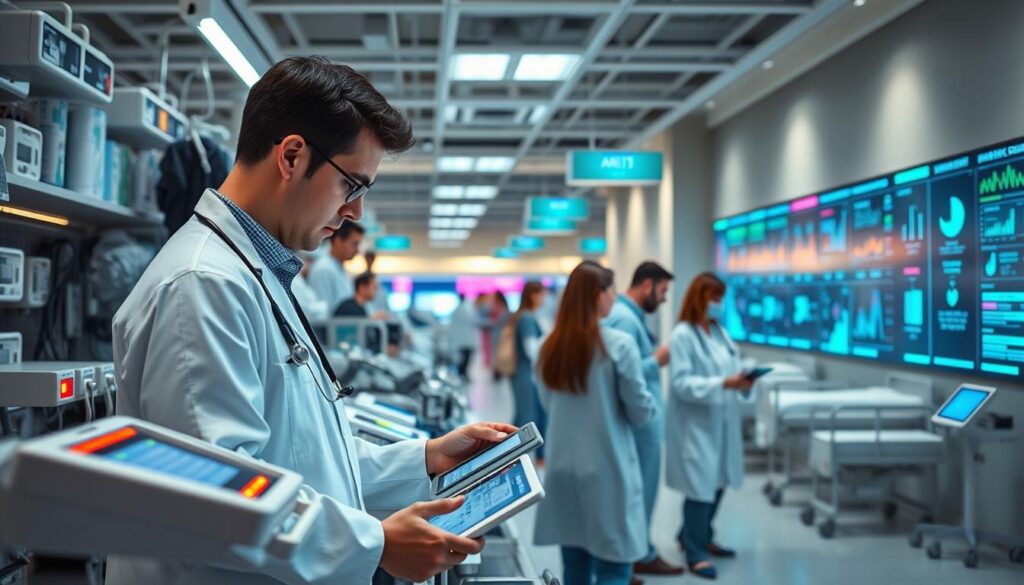
Real-world studies and deployments show concrete benefits. Examples such as Ping An improving diagnostic accuracy by 15% and URMC’s device-driven workflows prove the potential beyond pilots.
Practical approach: start with high-yield, low-friction use cases, set clear KPIs, and establish model monitoring and version control. Leadership commitment and cross-functional management shorten time from pilot to production.
Risk note: scaling fleets toward 100M devices raises security demands. Providers should adopt security-by-design, standardize interfaces, and harden governance before broad rollouts.
Iottive helps healthcare organizations de-risk early deployments through rapid prototyping, BLE integration, and production-grade cloud and mobile orchestration—so teams can move from proof-of-concept to measurable benefits on a predictable timeline.
The Hospital Safety Landscape: Risks, Adverse Events, and the Case for AIoT
Medical error estimates and underreported adverse events reveal a large, hidden gap that endangers patients and strains clinical teams.
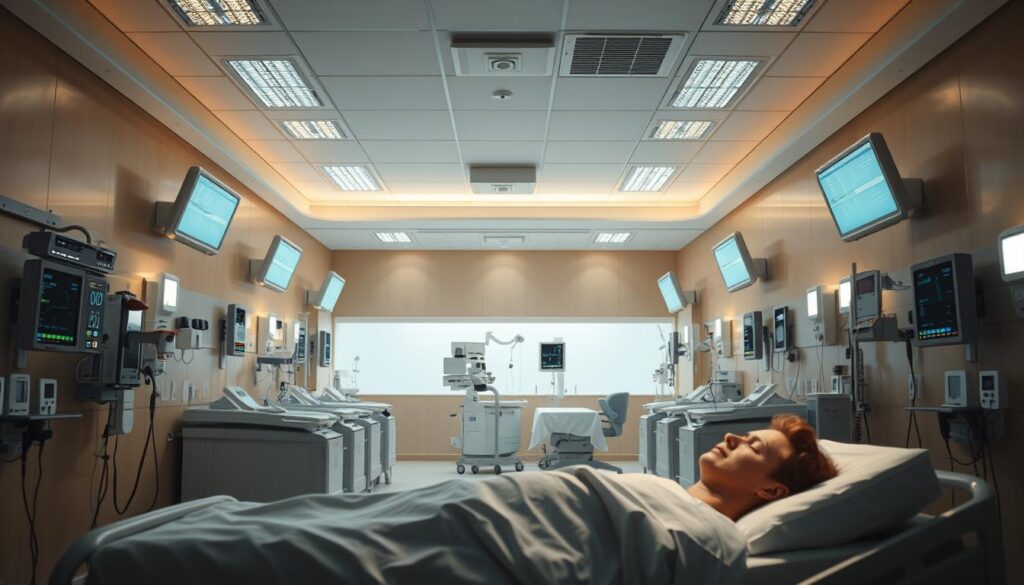
Underreported errors, falls, and pressure injuries
Annual U.S. deaths from medical errors range from 45,000 to 98,000. Fewer than 10% of errors are reported, and only 15% of responses stop repeat incidents.
High-frequency harms—falls, pressure injuries, and medication mistakes—extend length of stay and hurt quality ratings. These events also raise costs and worsen patient outcomes.
From reactive reporting to proactive detection and prevention
Manual reporting misses early warning signals. Continuous sensors, wearables, and bedside monitors provide real-time detection and richer clinical context.
Multiple studies show NLP and ML improve adverse event classification and reveal under-reporting trends. That gives safety teams timely insights for targeted management.
| Challenge | Impact | How continuous detection helps |
|---|---|---|
| Under-reporting | Lost learning, repeat incidents | Automated incident capture and trend alerts |
| Falls & pressure injuries | Longer stays, worse outcomes | Risk scores + predictive models to prioritize care |
| Device diversity | Integration and data gaps | Unified data management and secure workflows |
Iottive’s end-to-end solutions can integrate sensors, BLE apps, and cloud analytics to increase visibility into adverse events and support earlier preventive actions. Pairing tech with training and governance helps clinicians trust signals and act fast.
AIoT Reference Architecture for Safer Hospitals
A modular systems blueprint ensures devices, gateways, and apps work together to prioritize patient risk and streamline workflows.
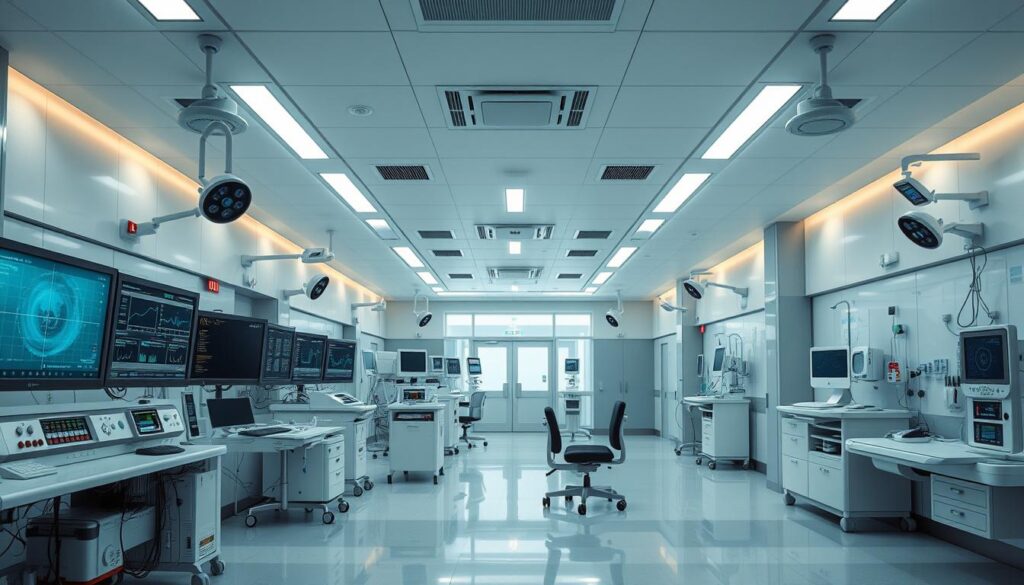
Devices and sensors
Define three device tiers: wearables for continuous vitals and movement, bedside monitors for clinical telemetry, and BLE smart devices for local context like posture or bed-exit.
Each tier supplies complementary signals for risk scoring, fall detection, and early intervention.
Edge AI, gateways, and network
Gateways buffer and preprocess raw data, run initial algorithms, and enforce data minimization to cut latency and bandwidth.
Design networks with QoS for clinical traffic, segmented device zones, and redundant routes so critical alerts bypass local outages.
Cloud and mobile app layers
The cloud unifies identity, analytics, and audit logs. Mobile apps deliver tasking, nurse alerts, and confirmation loops tied to workflows.
Iottive’s BLE App Development and Cloud & Mobile Integration streamline device onboarding, secure transport, and clinician-facing apps that connect to back-end systems.
Data flows into clinical records
Use standards-based APIs and event-driven updates to push alerts and documentation into electronic health records. That keeps clinician workflows intact and records consistent.
| Component | Role | Key controls |
|---|---|---|
| Wearables | Continuous vitals & motion | Device identity, signed firmware |
| Gateways/Edge | Preprocessing & initial models | Versioned models, telemetry for drift |
| Cloud & Apps | Analytics, alerts, workflow mgmt | Access control, audit logs, egress verification |
Example path: BLE wearable → mobile app → secure gateway → cloud analytics → EHR and nurse app alert with round-trip acknowledgment. Governance, change control for models, and modular design let teams scale systems without rebuilding core components.
Best Practices for Clinical Risk Detection and Early Intervention
Combining signal filtering with contextual text analysis helps teams spot risk before an event occurs. Practical pipelines tie device streams to clinician workflows so alerts lead to timely intervention.

Signal processing and anomaly detection for vitals and behavior
Robust processing starts with filtering, feature extraction, and artifact rejection to make vitals and motion data reliable.
Use layered anomaly detection: simple thresholds, statistical baselines, and ML-based change detection to flag early deterioration or unsafe movement patterns.
NLP to classify incident reports and free-text notes
NLP pipelines should normalize text, extract entities, and classify narratives to reveal underreported events. That analysis expands incident capture beyond structured fields.
Predictive models for falls, medication errors, and pressure injuries
Build models with relevant features, fairness checks, and prospective validation. Pair predictions with clear interventions and digital checklists so teams can act and document outcomes.
| Practice | Why it matters | Operational tip |
|---|---|---|
| Signal preprocessing | Improves alert reliability | Standardize filters and log artifact rates |
| Anomaly tiers | Reduces false alarms | Combine thresholds + ML with escalation rules |
| NLP classification | Reveals hidden incidents | Validate on historical reports and clinician review |
Monitor model calibration and retrain on drift. Design alerts with concise messaging, urgency tiers, and clear next steps to avoid alarm fatigue and support clinician trust.
Iottive can operationalize signal processing and NLP pipelines, integrating BLE sensors with cloud inference and clinician apps to surface prioritized, context-rich alerts that improve patient safety and outcomes.
AIoT Hospital Safety
When devices stream validated data to intelligent services, care teams can act before incidents escalate.
Define it: a coordinated approach where connected systems send continuous signals to services that anticipate and mitigate risks. This system links sensors, mobile apps, and cloud analytics to reduce wait times and guide emergency response.
Design matters: sensor accuracy, secure connectivity, resilient backends, and clear clinician apps form the backbone of reliable safety systems.
Governance and management set thresholds, audit alerts, and align goals across nursing, informatics, and quality teams. That oversight turns alerts into documented care actions in dashboards and the EHR.
| Capability | Benefit | Operational note |
|---|---|---|
| Edge intelligence | Low latency alerts | Local models with cloud oversight |
| Integrated platform | Single source of truth | Fewer duplicate tools, lower training load |
| Portable solutions | Consistent care across units | Follow patients from ward to remote settings |
Trust and transparency are essential: every alert should show why it fired and what data supported the decision. That clarity helps clinicians act with confidence.
Iottive’s end-to-end solutions integrate sensors, BLE apps, and cloud analytics to deliver portable, scalable systems that improve patient safety and care quality.
Security-by-Design for Connected Care Beyond Hospital Walls
Encryption is necessary but not sufficient. With over 86 million connected healthcare devices in 2024 and counts rising toward 100M, protecting patient data as care moves off-site requires layers of verification and active controls.
Going beyond encryption: verifying destinations and egress control
Encrypted channels can still carry packets to malicious endpoints. Validate destinations and enforce egress policies so outbound device data only reaches authorized servers.
Practical controls include deny-by-default egress lists, allowlists of trusted IPs, and automated alerts for unknown destinations.
Smartphone-as-conduit risks: malware, rogue apps, and public networks
Smartphones can introduce risks from rogue apps, unsecured Wi‑Fi, and man-in-the-middle attacks. App integrity checks, certificate pinning, secure BLE pairing, and transport protection are essential.
Hardening mobile apps preserves clinician experience while protecting clinical monitoring and patient flows.
Continuous traffic observability and anomaly detection
Monitor device, app, and cloud layers for anomalies—unexpected IPs, unusual volumes, or odd timing. Combine flow logs with behavioral algorithms for rapid detection and automated quarantining.
- Use signed firmware, hardware root of trust, and secure boot to block tampering.
- Enforce least-privilege access, network segmentation, and role-based controls for device management.
- Prepare incident playbooks: fast key rotation, containment, and forensic logs.
Iottive builds BLE-to-cloud pipelines with endpoint verification, signed firmware, and app hardening so providers can deploy secure systems without slowing time-to-value for patient monitoring use cases.
Interoperability and EHR Integration Without Disruption
Standards-based integrations let device insights appear where clinicians already work, not in separate dashboards. That reduces friction and keeps documentation consistent across teams.
Standards-based data models and APIs (HL7/FHIR)
Use HL7/FHIR as the core data model and deploy event-driven APIs so alerts land in the correct charts and queues. Map device metadata and provenance to standard fields to preserve traceability.
Aligning alerts and documentation within clinician workflows
Design alerts to match existing templates so staff can acknowledge, act, and record interventions without extra steps.
- Define an interoperability strategy centered on FHIR resources and event subscriptions.
- Normalize records fields and device data to keep quality high across systems.
- Enable bi-directional updates so clinician actions feed model training and audit trails.
- Work with EHR change control to schedule, test, and deploy without disrupting operations.
- Engineer for low-latency delivery, retries, and role-based routing to reach the right caregivers.
Iottive’s Cloud & Mobile Integration aligns alerts with HL7/FHIR workflows, enabling seamless documentation and minimal disruption for clinical staff. Track metrics like acknowledgment time and documentation completeness to improve quality and efficiency over time.
High-Impact AIoT Safety Applications and Real-World Examples
Connected applications are already changing how healthcare teams detect risk and allocate resources. These solutions link sensors, clinician apps, and analytics to deliver timely, actionable alerts.
Smart hospitals: asset utilization, emergency response, and resource routing
Real-time asset tracking improves equipment availability and reduces wasted searches. Automated emergency response can reroute teams and ventilate load to the highest-acuity patients.
Outcome: faster response times and better staff coordination during surges.
Remote monitoring for chronic conditions and early escalation
Continuous home monitoring models detect early deterioration for patients with chronic disease. When thresholds trigger, clinicians get prioritized alerts for escalation and follow-up.
This use reduces readmissions and strengthens continuity of patient care.
Incident classification improvements with ML and NLP
NLP and machine learning raise incident detection accuracy and speed. Valley Medical Center’s Xsolis work and Ping An’s AI gains show how algorithms improve classification and diagnostic outcomes.
“Portable imaging at the bedside and AI-embedded telehealth shift diagnostics earlier in the care path.”
Examples like URMC’s Butterfly iQ and Teladoc embed analytics into workflows so clinicians act on better context.
| Application | Benefit | Real example |
|---|---|---|
| Asset tracking & routing | Less downtime, faster response | Automated resource routing in emergency units |
| Remote monitoring | Fewer readmissions, early escalation | Chronic care alerts tied to clinician dashboards |
| NLP-driven incident classification | Faster, more accurate triage | Valley Medical Center / Xsolis; Ping An gains |
Iottive builds custom IoT platforms and BLE apps that support these applications end-to-end, from sensor integration to clinician-facing mobile and analytics dashboards. Robust governance, labeling standards, and retraining protocols keep models reliable as systems scale.
Measuring What Matters: Outcomes, Quality, and ROI
Measuring impact starts with clear, actionable metrics that link device signals to real care outcomes. Good measurement shows whether monitoring and alerts actually improve patient care and operational performance.
Safety KPIs: event detection and response
Define near‑real‑time KPIs such as event detection rate, time-to-intervention, and reductions in falls, pressure injuries, and medication errors. Evidence shows NLP and ML can raise detection and classification rates, while fall prediction tools support targeted nursing interventions.
Operational KPIs: throughput and staff efficiency
Track throughput gains, readmission reductions, and staff task efficiency. Link these measures to program maturity so improvements reflect both tech and workflow adoption.
Data pipelines and analysis
Capture timestamps, acknowledgments, and intervention details so analyses are auditable. Use pre/post comparisons, difference‑in‑differences, and unit-level benchmarking to attribute impact.
- Create dashboards that roll up outcomes across units and permit drill-down by cohort, device, and workflow.
- Run ongoing analysis to verify alerts led to timely, appropriate actions and that gains persist over quarters.
- Connect quality metrics to governance so results drive model updates, escalation policies, and training priorities.
“Measurement maturity is foundational to sustaining investment and scaling monitoring programs enterprise‑wide.”
Financial view: reduced harm costs, avoided transfers, and productivity gains should feed ROI models and justify continued investment. Iottive supports KPI instrumentation across devices, apps, and cloud analytics and provides dashboards that tie safety improvements to operational and financial impact.
Implementation Roadmap: From Pilot to Enterprise Scale
A clear roadmap turns experiments into reliable, enterprise-grade systems without surprising clinicians or IT.
Use-case selection and data readiness assessment
Start with a focused phase that targets a high‑value use. Define objectives, scope, stakeholders, and success metrics so the pilot proves clinical value quickly.
Assess signal quality, labeling, and data availability. Good data readiness reduces algorithm drift and speeds time to trusted alerts.
Edge-to-cloud architecture validation and security hardening
Validate the edge-to-cloud system for reliability, redundancy, and endpoint verification. Lock egress policies and apply app hardening to protect patient flows.
Clinical workflow design, training, and change management
Co-design alerts with clinicians so each notification maps to clear actions. Train clinical and technical staff and set governance to manage releases and feedback.
Phased rollouts with continuous model monitoring
Execute phased rollouts by unit or use. Track KPIs to guide go/no-go decisions and resource allocation.
- Monitor models for drift, retrain on schedule, and log performance.
- Integrate cyber testing and incident playbooks into every phase.
- Capture lessons in a reusable playbook to speed future phases.
Iottive offers end-to-end solutions to build pilots, secure BLE integration, and support enterprise rollouts with training and change management so healthcare teams scale with confidence.
Ethics, Governance, and Compliance in AI-Enabled Safety
Robust oversight ensures model outputs support clinician judgment and protect patient rights. An explicit governance approach clarifies who reviews models, how bias is measured, and when tools must be retired.
Bias, transparency, and human-in-the-loop safeguards
Define an ethics approach that includes bias testing across demographics and clear remediation plans. Document limitations so clinicians understand where models may underperform.
Require human-in-the-loop safeguards for high‑stakes alerts. Clinicians must be able to override recommendations and add feedback that feeds retraining pipelines.
Auditability, incident learning systems, and continuous improvement
Implement comprehensive audit trails: capture inputs, model version, decision traces, and timestamps. These records support internal reviews and regulatory inquiries.
Pair incident learning systems with near-miss reporting so the system improves from real events. Use studies that test models in practice, not only in silico, to confirm sustained gains in detection and quality.
- Establish governance bodies to set deployment thresholds, performance metrics, and sunsetting rules.
- Promote patient-centered practices: clear notices, consent, and simple explanations of monitoring and data use.
- Align compliance with usability so clinicians can work efficiently while meeting regulatory demands.
“Transparent model operations, audit trails, and clinician-friendly interfaces strengthen trust and compliance.”
Iottive supports transparent model operations and explainable alerts so teams can measure experience, protect patients, and keep intelligence systems accountable as they scale.
Partnering with Iottive Pvt. Ltd. for End-to-End AIoT Safety Solutions
Working with specialists who bridge devices, cloud, and clinical workflows reduces risk and shortens timelines. Iottive offers end-to-end solutions that help teams deploy connected systems faster and with clear outcomes.
IoT & AIoT expertise: BLE app development, cloud & mobile integration
Iottive builds BLE app stacks and secure mobile clients that enable rapid onboarding of medical devices. Low-latency data paths and hardened transports deliver reliable signals for clinician tools and analytics.
Custom IoT platforms for Healthcare and Smart Hospitals
Custom platforms unify sensors, gateways, cloud analytics, and workflow integrations. These systems map device metadata to electronic health records and minimize disruption to daily care.
Get started: www.iottive.com | Sales@iottive.com
How we work: discovery workshops, pilot builds, validation testing, and phased enterprise rollouts with training and change management. Our products and accelerators reduce risk and cut time-to-value so teams see measurable benefits.
- Rapid BLE app development and secure device onboarding for clinical use.
- Platform capabilities that tie sensors, edge intelligence, and cloud analytics to workflows.
- Alignment of applications like fall detection and incident classification to enhance patient care and staff efficiency.
- Standards-based EHR integration to streamline documentation and reduce duplicate work.
- Security-by-design: device identity, signed firmware, and endpoint verification beyond hospital walls.
Iottive is a long-term partner focused on clinician experience, continuous improvement, and measurable impact. Contact us at www.iottive.com or Sales@iottive.com to schedule an assessment, demo, or design session.
Conclusion
Adopting always‑on sensing and near‑real‑time intelligence lets care teams stop many avoidable incidents before they occur.
Across healthcare, the market’s rapid growth and real deployments show this article’s promise: continuous monitoring, edge models, and cloud oversight drive better patient safety and measurable outcomes.
Success depends on secure, interoperable systems that fit clinician workflows, strong governance, and continuous model monitoring. Encryption alone is not enough; destination verification and observability must keep pace as care extends to smartphones and home networks.
, Iottive is ready to support providers with IoT & solutions, BLE App Development, and Cloud & Mobile Integration to operationalize safer, smarter care. Contact: www.iottive.com | Sales@iottive.com.
FAQ
What does AIoT mean for modern hospital patient safety?
AIoT combines connected sensors and devices with on-device and cloud-based intelligence to detect clinical risks earlier, automate alerts, and support staff workflows. This approach improves monitoring of vitals, movement, and environmental factors so teams can intervene faster and reduce falls, pressure injuries, and medication errors.
How do edge AI and cloud systems work together for timely interventions?
Edge AI processes critical signals locally—shortening detection-to-alert time—while cloud systems handle aggregation, long-term analytics, and model training. That split preserves bandwidth, maintains low latency for urgent events, and enables continuous improvement from pooled data and clinical feedback.
Which devices and sensors are typically used in these solutions?
Common components include wearable monitors for heart rate and motion, bedside physiologic monitors, BLE-connected asset tags, pressure-sensing mattresses, and environmental sensors. Together they provide diverse data streams for multi-signal detection and contextual algorithms.
Can these systems integrate with existing electronic health record (EHR) systems?
Yes. Standards like HL7 FHIR and documented APIs enable secure data exchange, clinician-facing alerts, and automatic documentation in workflows. Proper mapping and testing reduce disruption and keep clinical context synchronized between devices and the EHR.
What clinical problems see the biggest near-term impact?
Early detection of patient deterioration, fall risk prediction, pressure injury prevention, and medication safety are high-impact areas. These use cases benefit from multimodal signals, predictive analytics, and closed-loop notification to clinicians and rapid response teams.
How do NLP and machine learning improve incident classification?
NLP parses free-text notes and incident reports to surface patterns, root causes, and severity. ML models then classify events and prioritize which require immediate human review. This reduces manual triage time and reveals trends for prevention.
What security measures matter beyond encryption?
Strong security requires destination verification, least-privilege egress controls, device attestation, continuous traffic observability, and regular penetration testing. Securing mobile endpoints and defending against rogue apps or public-network threats are also essential.
How do you measure success and ROI for these deployments?
Track safety KPIs—event detection rates, time-to-intervention, fall and injury reductions—and operational KPIs like throughput, readmissions, and staff efficiency. Combine quantitative outcomes with cost-savings estimates from avoided incidents to build ROI cases.
What are common implementation risks and how are they mitigated?
Risks include poor data quality, clinician alert fatigue, integration gaps, and model drift. Mitigation includes phased rollouts, clinician co-design, threshold tuning, rigorous validation, and continuous monitoring with human-in-the-loop review.
How should hospitals approach pilots versus enterprise scale?
Start with targeted pilots on high-value use cases, validate data readiness and edge-to-cloud flows, and refine workflows. Use phased expansion with standardized onboarding, model governance, and security hardening before enterprise rollout.
What regulatory and ethical concerns apply to AI-enabled safety tools?
Address bias in training data, ensure transparency of model decisions, maintain audit logs for traceability, and keep human oversight for critical decisions. Compliance with HIPAA and medical device regulations must guide deployment and monitoring.
How do these systems handle interoperability across vendors and platforms?
Adoption of open, standards-based data models and APIs—FHIR for clinical data, and industry messaging standards for device telemetry—facilitates vendor-agnostic integrations and smoother alignment with clinician workflows.
What operational changes are needed for clinical staff?
Staff need training on new alert behaviors, escalation protocols, and device interactions. Change management should include simulation sessions, clear roles for response, and mechanisms for feedback to tune algorithms and workflows.
Can remote monitoring extend care safely beyond inpatient settings?
Yes. Remote monitoring for chronic conditions and post-discharge surveillance enables early escalation when risks rise. Secure mobile integrations and validated data pipelines help maintain continuity while protecting patient privacy.
How do hospitals ensure continuous improvement after deployment?
Implement incident learning systems, routine model revalidation, performance dashboards, and clinician feedback loops. Continuous data collection and retraining reduce drift and improve detection accuracy over time.